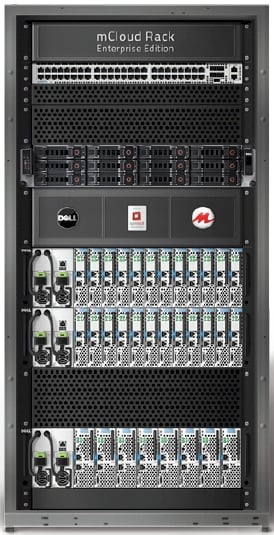This article is more than 1 year old
Morphlabs forges OpenStack cloud rack
Ready to run virty machines
Morphlabs has been moving into physical hardware over the past two years and is now rolling out a converged system called mCloud Rack Enterprise. The system welds together Dell cloudy servers packed with solid state storage, Nexenta storage software, Arista Networks switches, and the new "Essex" commercial-grade OpenStack cloud fabric into a ready-to-go "cloud in a box".
The company got its start in 2007 peddling the Appspace cloud management tool on top of Amazon's EC2 compute cloud.
The machine, rolled out today at the OpenStack Design Summit and Conference being held in San Francisco, is based on Dell's PowerEdge-C cloud boxes, which are semi-commercialized versions of the custom and super-dense servers that Dell's Data Center Solutions division has been building for the past five years and that now account for well over $1bn in sales.
The mCloud Rack Enterprise is not based on the PowerEdge-C6100 two-socket servers, according to Yoram Heller, vice president of corporate development, but rather on the C5220 "Viking" sled servers based on single-socket microservers that Dell announced in March 2011. The C5220 supports Intel's Xeon E3 processors and up to four memory slots for a maximum of 32GB of memory capacity. This Viking chassis is 3U tall and has room for a dozen of these microservers, and the base mCloud Rack Enterprise configuration comes with two of these sleds.

The mCloud Rack Enterprise stack
Morphlabs is using a PowerEdge-C2100 server as a storage node, which it equips with 12TB of solid state disk and stuffs it with NexentaStor, a storage software stack from Nexenta. The storage upstart is a big fan of the OpenSolaris variant of Unix and the related Zettabyte File System (ZFS), which were both open sourced by Sun Microsystems six years ago and which are now controlled by Oracle. Nexenta is one of the companies behind the Illumos fork of OpenSolaris. In any event, the C2100 server is a two-socket server that has room for a dozen 3.5-inch SATA drives across its front plus two internal bays for local storage to run the Nexenta software.
The storage and server nodes are linked to each other and to the outside world with an Arista 7050T 10 Gigabit Ethernet switch, which has 48 10GE ports plus four 40GE ports that can be equipped with line splitters to push it up to 64 10GE ports. In the rack above, there's one switch, one C2100 storage array, and three C5220 sleds in a half rack chassis with lots of room left in it.
Heller says that the initial configuration is suitable for supporting around 150 virtual machines, which are controlled by OpenStack and implemented using the KVM hypverisor. The flash array can deliver around 10,000 IOPS of storage bandwidth to each VM running in the box, and the entire array can pump something on the order of 10X the IOPS of Amazon's Elastic Block Storage service, according to Heller. A 300 VM setup, including storage, costs $180,000, or about $600 per virtual machine.
That may sound like a big price, but go load up VMware's vSphere and vCloud Director stack on the same servers, and Heller says you can easily spend three times as much money building a converged stack.
"Cloud is more than a software problem, it is a systems problem," says Heller. "You're going to easily spend $200,000 fussing around with OpenStack yourself and you are not going to have a solution when you are done."
The mCloud Rack Enterprise stack is available for order now and is shipping to early adopter customers. It will be generally available in early May. ®
